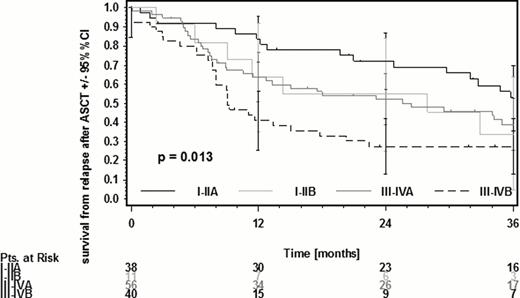Abstract
Abstract 2633
Today, most patients with Hodgkin Lymphoma (HL) can be cured at first diagnosis. For HL patients suffering from relapse or progression after first line therapy, high dose chemotherapy followed by autologous stem cell transplant (ASCT) is the treatment of choice and cures about 50% of these patients. Those who relapse or progress after ASCT have a very poor prognosis and clearly represent an area of unmet medical need. However, data on this small group of patients is rather limited and no established risk factors are available. Here, we present a recent retrospective analysis from the GHSG database to better characterize HL patients with relapse or progression after ASCT in order to define possible risk factors for the prediction of overall survival.
All trials in the GHSG database were searched for HL patients who relapsed or progressed after ASCT. The information for this retrospective analysis was updated in May 2012. Overall survival after progression of HL following ASCT (OSrr) was the end point of this study. Descriptive statistics and Kaplan Meier estimates of OSrr were used and risk factors for OSrr analyzed. The significance level was set to 0.05.
152 patients who relapsed or progressed with HL after ASCT were identified. 149 patients fulfilled the predefined inclusion criteria. With a median observation time of 65 months after progression, 112 patients (75%) had died. OSrr was 63% (95% confidence interval [CI]; 54% to 70%), 51% (95% CI 42% to 58%), and 20% (95% CI 13% to 28%) at 1, 2 and 5 years, respectively. From several risk factors tested, stage (p=0.044) and presence of B-symptoms (p=0.005), both at relapse before ASCT, significantly predicted OSrr. Combination of these two risk factors allowed the identification of three distinct risk categories for the 4 significantly different groups (p=0.013; Figure 1). Accordingly, patients in clinical stage I or II without B-symptoms had a somewhat better prognosis (OSrr 84% [95% CI 67% to 92%], 72% [95% CI 54% to 84%] and 33% [95% CI 18% to 49%] at 1, 2 and 5 years, respectively). Other potential risk factors such as stage at first diagnosis (p=0.80), early, late or multiple relapses before ASCT (p=0.95), and time from ASCT to further progression of HL (p=0.81) were not significant.
Current treatment approaches for patients with relapsed or progressive HL after ASCT show disappointing results with 80% of this very high-risk group dying within 5 years. Emerging new drugs such as brentuximab vedotin might improve the outcome of these patients in the future.
OSrr for a combined risk factor from presence of B symptoms and dichotomized clinical stage at relapse before ASCT.
OSrr for a combined risk factor from presence of B symptoms and dichotomized clinical stage at relapse before ASCT.
von Tresckow:Takeda Pharma GmbH: Honoraria, Travel Grants Other. Borchmann:Millenium The Takeda Oncology Company: Research Funding; Takeda Pharma GmbH: Travel Grants, Travel Grants Other. Engert:Millenium The Takeda Oncology Company: Honoraria.
Author notes
Asterisk with author names denotes non-ASH members.


This feature is available to Subscribers Only
Sign In or Create an Account Close Modal